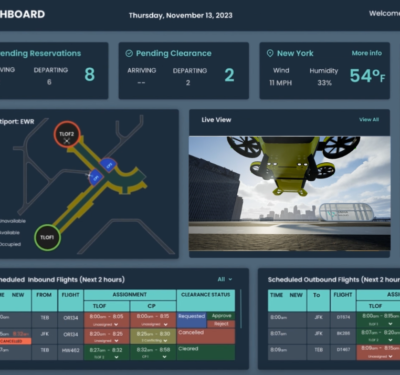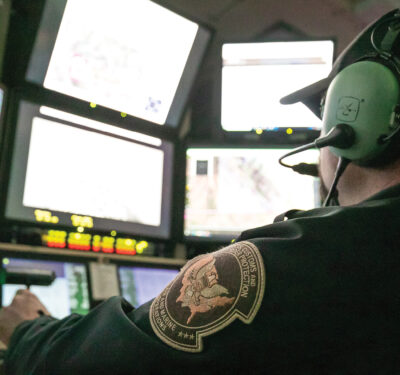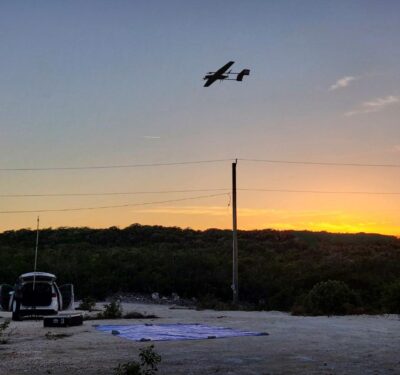
I’ve been on the ‘counter unmanned aerial systems (UAS)’ circuit a lot over the past few months. I spoke at the first Director of National Intelligence (DNI) conference on counter UAS in DC two months ago, at the National Association of Broadcasters convention in Vegas last week, will do a DNI/NORTHCOM counter UAS exercise next week and then lead two panels at AUVSI’s Xponential in Dallas the week after. Every time I attend a counter UAS shindig, I’m reminded not of 21st century America but of medieval India, elephants and blind men.
If you are wondering why, I will remind you of the ancient Indian parable about a group of blind men who encounter an elephant for the first time. Each of the blind men touches a different part of the massive curiosity to figure out what it is. One thinks it’s a mighty tree because he touches its legs, another believes it is only a tree limb because he touches the trunk. The ears become fans, the tail a rope. The final blind man just sits in the road because he touches the belly and concludes it was a wall. When they compare their experiences, they completely disagree.
We’re experiencing a similar thing in modern America as we encounter the challenge of counter UAS. Each agency and industry segment involved views this elephant through their own myopic lens, no one is seeing the big picture. Let’s consider how a few groups in the tribe are feeling their way through the problem right now.
The different detection tribes envision this strictly as a sensor issue. The radar detection dudes perceive this as a simple problem; radars work in all weather and they just have to develop the right algorithm to sort birds from drones. The advanced sensor detection advocates feel sorry for the radar dudes because they know radars really can’t sort birds from drones and only infrared sensors can detect drones from their engine heat. The cybersecurity clan thinks the other three detection tribes are so medieval. Drones must have data links, right? Just geolocate the data links.
The counter engagement population is waiting for the detection tribes to make up their minds so they can swoop in and take down the bad elephants… I mean drones. Their engagement methods range from jammer beams that take out the links/GPS, to rockets with big nets inside, to missiles, to feathered falcons (go Emeriti Air Force!), to the USAF with good ol’ fashioned shotgun shells.
The legal kindred are the final group, but all of them unanimously detected a big wall and just sat down. The lawyers know drones are legally commercial aircraft and therefore only a few select federal agencies can legally down a drone. Only the DoD, the Secret Service (if the President is involved) and the Department of Energy (over nuclear facilities) have the authority to down drones right now. All other law enforcement authorities can only engage the aircraft if a person is in imminent danger of death from a drone.
Back to ancient India.
There are some obvious problems with how medieval India approached elephant ID that will help with our counter UAS challenge. The first problem was the blind men should have talked to other and at least agreed they were dealing with some sort of animal. I can see mistaking the trunk for a snake, but a tree branch? It’s the same with our 21st century counter UAS crowd. Can’t they at least get together and agree we’re dealing with aircraft here? Not toys, radar tracks, hot spots or bleeps. Aircraft with the pilot on the ground.
My next problem with our Indian friends was they should have asked themselves how they previously identified other animals. Do trees really breathe and have toes? Our counter UAS crowd has the same problem. If we’re dealing with aircraft, then how have we identified, tracked and engaged manned aircraft for the past two centuries?
Of course, the final problem with the blind men story is that medieval Indian villagers were real jerks. Why didn’t they use the superior sensing capability and impressive animal identification catalogue of the entire village to tell the blind men they were feeling an elephant? What about us? Do we have a 21st century village that can help us identify bad drones?
Trust me, the USAF has a very well developed, worldwide “village” of people and tools to help them identify and then defend against hostile manned aircraft. Many people think the Air Force just stares at sensors and the bad tracks jump right out at them. That’s not how they do it. The first thing they do to find bad guys is to filter out all the good guys (friendlies). Then they’re left with a smaller number of unidentified tracks (bogies) they concentrate on to decide which bogies are bad guys (bandits). Once they’ve sorted the tracks, the Air Operations Center (AOC) has the authority to engage fighters or missiles against the bandits and all the bad guys tracks disappear shortly after.
The tough part is accurately identifying the friendlies. The Air Force makes all their friendlies equip IFF (transponders that reply with a secret code when interrogated). To aid ID, they also require friendlies to comply with airs traffic measures that identify them as friendly by the way they navigate the airspace. Example, only attack targets from the north, fly in specific “lanes” through friendly defenses. The USAF uses a sophisticated system called the Theater Battle Management Control System (TBMCS) to tie it all together so the AOC knows who are all the friendlies.
After the AOC sorts the friendlies, reconnaissance crews start identifying the bandits among the remaining bogies – the tracks that either didn’t have the right electronic ID or who flew in areas they weren’t supposed to. I can’t talk about all measures used, but suffice it to say that if the bad guys turn on anything electronic, recce crews have its signature and can mark them as a bandit. If bogies were radio-silent, fighters engage and use radar, infrared sensors or even their eyes to decide if bogeys are bandits.
The point is, unlike our blind medieval Indians and their village, the Air Force ensures every one cooperates with each other and uses multiple methods to ID objects. Can a similar approach for unmanned aircraft? We haven’t built a solid counter UAS system, but we have the makings.
We’re working on our ability to sort good friendly drones from bandits. The FAA is wisely convening a Remote Identification and Tracking Aviation Rulemaking Committee (ARC) soon. Done correctly, this ARC will yield the unmanned equivalent of military IFF codes. I hope the ARC yields remote ID that fits with the unmanned version of the DoD’s TBMCS; NASA’s Unmanned Traffic Management (UTM) system. Few think of UTM as key to the counter UAS problem, but functional air traffic management system is vital to showing where are the friendlies so we can concentrate on finding the bandits.
The FAA also just started releasing two types of airspace control measures that are crucial to the counter UAS problem. First, they released a series of drone Temporary Flight Restrictions (TFRs) over military bases and other critical infrastructure. This makes it easier to ID bandits because no one should fly there. The FAA started releasing UAS Facility Maps that break the areas around controlled airspace into gridded blocks with refined airspace authorizations for drones. Using this information plus a new gateway being built to the FAA’s national airspace systems and a new web portal called Low Altitude Authorization and Notification Capability (LAANC), UAS flight authorizations will eventually become nearly automatic in airspace currently off limits to today. Working together, things like remote ID, NASA’s UTM and FAA’s UAS airspace control measures will make it much easier to filter out authorized UAS flight and hone in on those bandits for security actions.
But how do we track UAS that aren’t playing by the rules? That’s where the detection crowd comes to the rescue, but like the traffic management folks, they must work together to find drone bandits. All three of the detection groups mentioned earlier are correct about the strengths/weakness of each other. Radar is reliable, but has trouble sorting birds from drones. Infrared will pick up hot drone engines but it doesn’t work well in weather. Cyber detection works great to precisely ID the type of drone and possibly allow authorized hacking of its data link, but what if the drone is programmed to attack autonomously? However, could a carefully combined radar, infrared, cyber detection capability be effective against all threats? You bet.
Finally, what can we do about those clearly hostile bandit drones? Right now, not as much as anyone would like. The lawyers are correct and only few agencies can engage hostile drones under the law today. If a drone isn’t attacking the President or a nuclear facility it’s up to the DoD to engage. The Air Force are great folks, but they don’t have the budget to defend all our critical infrastructure and fight everyone else. Congress needs to act. They need authorize other law enforcement entities to engage bandit drones.
With the correct authorities in place and the rest of our counter drone village working together to ID drones, we’re left with our one “fun” problem – taking out bandit drones. If there was ever one thing the United States of America is better at than any other nation on earth, it is taking down hostile aircraft. I have no doubt we’ll solve this issue easily.
Once our tribes get together and act like a collaborative village, we will easily get past answering the question of whether it is a bird or a plane, and the village will realize that countering bandit drones is the elephant in the room.






